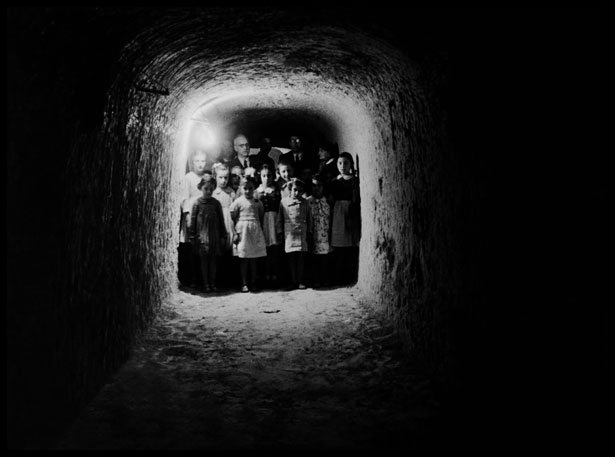
[Civilians in an air-raid shelter, Minorca, Spain], December 1938. © David Seymour/Magnum Photos
It’s a strange photograph, something like a class portrait from a school under siege. In it, the pitted walls of an air raid shelter frame a dozen or so children and their caretakers behind them, peering out of the darkness. A naked light bulb casts a dim glow over the students as they stare at the photographer, hands resting at their sides. Their gaze draws the viewer into and down the shelter’s length. Do their faces betray fear, or a wary concern over the disruption of their daily routine?
Even though it doesn’t show maimed bodies or stiffened corpses, the image is a war photograph. Taken on the Mediterranean island of Minorca in December of 1938, it is a strikingly humanizing missive sent from the short-lived Second Spanish Republic’s battle for survival against Generalissimo Francisco Franco and his fascist forces. More generally, it shows what war was like for much of Europe’s peoples in the 1930s and 1940s: random periods of defenseless waiting, sometimes terminated by deaths of varying duration. The photographer was a 27-year-old Polish exile shooting for a large European audience, and the children’s collective stare turns him into a medium for an intense identification between Spain’s afflicted and the world beyond the shelter’s spot-lit darkness. Why did this photographer—working in a distinctly heroic partisan aesthetic tradition—focus on civilians rather than soldiers at the front?
Part of the answer has to do with the world he was photographing. In the course of his transformation from Dawid Szymin, the son of a publisher of Yiddish and Hebrew books; to Chim, committed photographer of French Popular Front politics; to David Seymour, citizen of the United States and veteran of its army, two conflicts had played themselves out across the globe, successively more grotesque in their technologies of killing and annihilation and the industrial scale on which they were used. Europe was in ruins at the end of those wars. Chim perceptively adapted his camera eye to the changed circumstances, and his best images offered possibilities for empathy that are distinctly original.
An exhibition at the International Center of Photography in New York City, on view through May 5, showcases Chim’s photography and surveys the magazines that were so central to his practice as a photojournalist. Negatives recovered in 2007 from the long-lost “Mexican Suitcase” [see “A Secret Archive,” January 24, 2011], along with never-before-seen color prints, add to the wealth of images culled from the collections of Chim’s extended family and the ICP. (The Minorca image was a gift to the center from Eileen Shneiderman, Chim’s older sister, and her son Ben.) Although Chim’s stylistic approach to his subjects changed over the course of the tumultuous wartime years, the heart of his work, a palpable and singular identification with ordinary people and their experience of violent upheaval, remains hauntingly consistent.
Popular
"swipe left below to view more authors"Swipe →
* * *
Chim’s career as a photographer began in Paris during the interwar years, in a cultural milieu that also fostered the work of fellow photographers Henri Cartier-Bresson and Robert Capa. From the beginning, Chim’s was a socially engaged practice: whether he was shooting for the leftist weekly magazine Regards or more mainstream outlets like the daily newspaper Paris-soir, his photographic essays centered on the workers who sustained France during the lean interwar period. His subjects ranged from the miners grubbing away under Paris to expand the métro, to the butchers at the famous Les Halles market, to life inside a Renault auto factory.
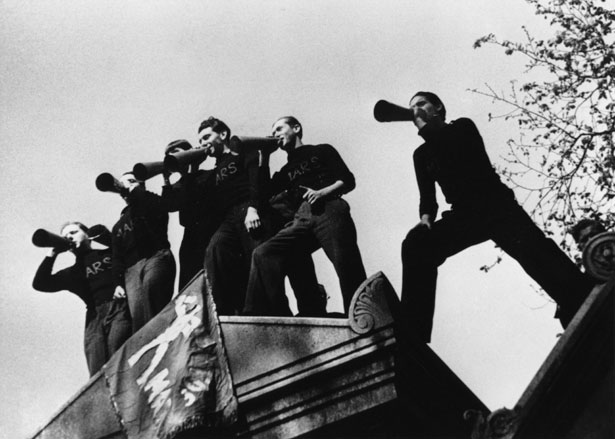
Demonstration in memory of those killed during the Paris Commune, Père Lachaise cemetery, Paris], May 1934. © David Seymour/Magnum Photos
When France’s Front Populaire—a coalition of socialists, communists and other leftist radicals—formed in 1935, Chim’s camera gave it full backing. The movement’s leaders were indulged with heroic low-angle shots recalling Alexander Rodchenko’s constructivist experiments in painting and photography. In one representative image, a young girl on a man’s shoulders raises a clenched fist in solidarity with those killed when the Paris Commune was crushed. The images are assured and idealistic, capturing an optimistic moment of the left ascendant. When France joined Spain in electing a Popular Front government in 1936, making Socialist Léon Blum the prime minister, it seemed that the advance of fascism—which had taken root in Germany and Italy and was threatening to spread—could be turned back, and that a left alternative to Stalin’s technocratic Soviet brutality might flourish.
But in Spain, Franco reacted swiftly to the Frente Popular’s 1936 electoral victory, leading a coup that escalated into all-out civil war. A clash of ideologies was joined. Chim traveled throughout Republican Spain, sometimes in the company of Capa and Gerda Taro, taking photos relaying its changes in fortune. While Capa, Chim’s opposite in temperament and photographic style, rushed to the front lines to see the war machines in action, Chim spent time with Spain’s farmers, fishermen and refugees. His images capture the newfound enthusiasm of men, women and children fighting for their political future: a crowd of raised fists and smiling faces fills the frame at a land reform meeting in Extremadura; a volunteer soldier in the International Brigade’s Ernst Thälmann Battalion shoots a confident look at the camera; and in an image previously attributed to Capa, a boy dressed in the garb of the Union of Proletarian Brothers walks through the streets of Madrid with what appears to be a toy gun over his shoulder.
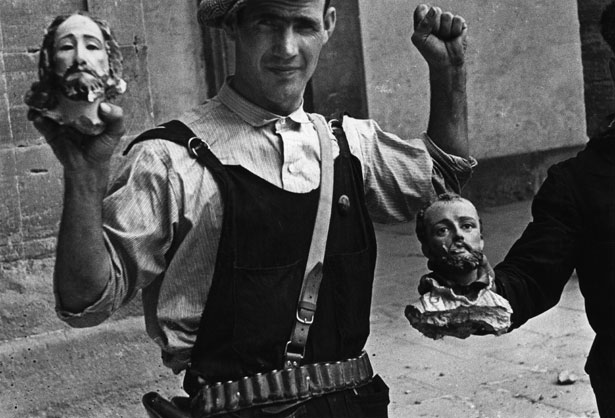
A Republican militia man poses for the photographer in front of an already ransacked church, Barcelona, July 1936. © David Seymour/Magnum Photos
But something changes Chim’s images during the course of the civil war, something that drew forth a political honesty that his French images lacked. Perhaps it was the devastation that Hitler’s Luftwaffe unleashed on the Basque town of Guernica in 1937, or perhaps the failure of friendly governments—most significantly Blum’s Front Populaire—to aid Republican Spain. Whatever the cause, uncertainty crept in.
It was during this time, his last months in Spain, that Chim photographed the children of Minorca in an air raid shelter. It was also during this time that he repurposed the heroic low angle he had previously reserved for Popular Front politicians and partisans at Père Lachaise. The result is a discomfiting composition of two men standing against a Madrid storefront. Letters hang askew on the building’s facade, and the store’s shutters cut claustrophobic lines behind the men’s backs. In a startling shift in tone and depth, and despite the stylistic continuities with Chim’s earlier work, the central figure looks into the camera with a mixture of reproach and anxiety. He was the first of Chim’s subjects to look warily at the lens and what it is capable of capturing.
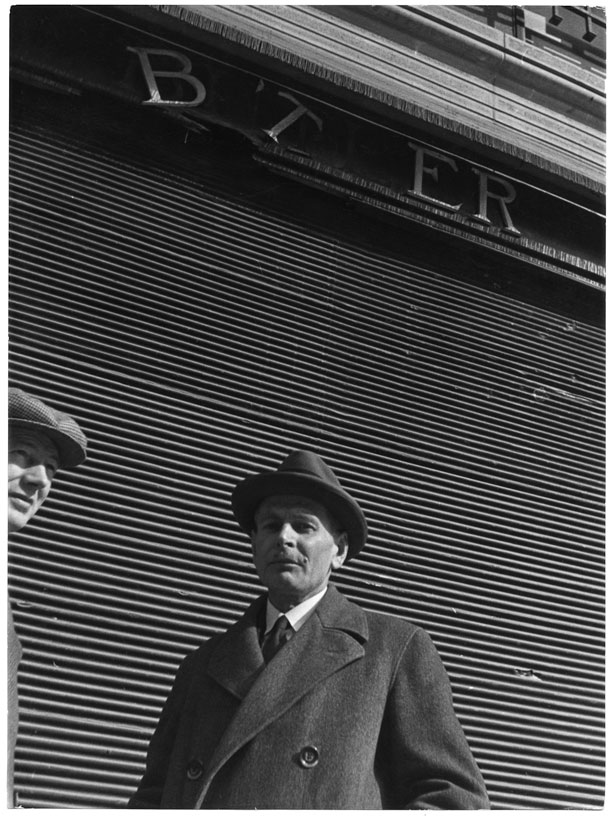
[Two men in front of a closed store, Madrid], ca. 1938. © David Seymour/Magnum Photos
* * *
When Spain fell to Franco in April 1939, Chim fled by ship to Mexico along with nearly 2,000 other refugees. From there he made his circuitous way to New York City, where he stayed until he enlisted in the US Army in 1942. He was assigned to a special unit whose task was studying surveillance photographs taken from retrofitted Spitfire fighter planes. Poring over these patchwork images of roads, fields and clusters of buildings left Chim little time for taking photographs of his own, and he published rarely until 1947.
Despite the hiatus, Chim’s craft was still committed: one of his first new projects was a sensitive survey of Europe rebuilding called We Went Back! He shows the signs of growth: a garden on the grounds of the Reichstag in Berlin, a baby smiling in the ruins of a building in Essen. After years of surveying the damage from thousands of feet above ground, he was immersing himself in the recovery and reconstruction taking root in the ravaged landscape. But he also shows the fear of the lens again: at the Buchenwald trial in Dachau, spectators shield their faces from his camera, ashamed at the crimes they, their loved ones or their countrymen committed during the war. Optimism is absent from these images.
Over the next nine years, Chim traveled throughout the continent, documenting the ever-tumultuous postwar political landscape. UNESCO drafted him for a compassionate portrayal of the children who made up Europe’s orphans, disabled and refugees. He documented Israel’s kibbutzim— a subject of particular importance to a photographer whose parents were killed by the Nazis in a ghetto outside Warsaw—just years after the foundation of the new state on the Palestinian lands from which Britain had withdrawn in 1948.
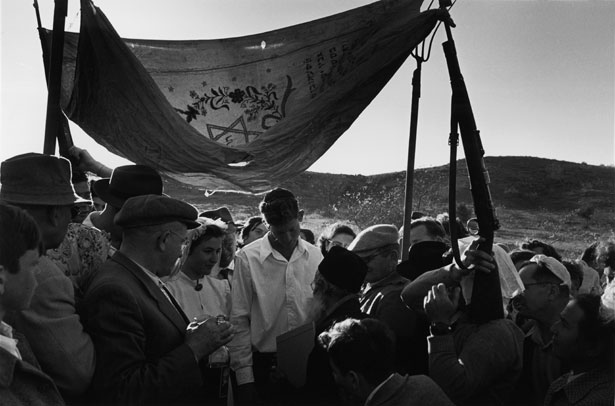
[Wedding under an improvised huppah, propped up with guns and pitchforks, Israel], 1952. © David Seymour/Magnum Photos
One of his most lasting contributions to the profession was the photo agency he founded in 1947 with Capa and Cartier-Bresson, joined by the British photographer George Rodger and the American William Vandivert. Magnum, as the agency came to be called, was revolutionary—operated by photographers, for photographers. “Why be exploited by others?” as Capa put it. “Let’s exploit ourselves.” Magnum made the photojournalist into an artist, and allowed its members—all of them freelancers—to exercise a measure of control over their work that was sorely lacking at the time. They could retain the copyright to their images and exercise final approval of the captions that accompanied their photos in magazines, enabling them to foil any editor who may have wanted to write a caption that would distort an image’s meaning. It was a revolutionary transformation of the trade, and Chim—with his careful, professorial demeanor—was pivotal to keeping its difficult personalities focused on a collective professional cause.
In 1956, everything ended suddenly for Chim: while he was working in Port Said, Egypt, during the Suez Canal crisis, Egyptian soldiers opened fire on his jeep and sent it hurtling into a canal.
* * *
It is difficult to create an intellectually honest, politically aware image, and Chim failed often. The explicitly partisan images of his French years are formulaic, little more than visually rich ideological documents of a time and place. And the photographs he snapped after the war of Ingrid Bergman, Sophia Loren and other celebrities for the new color-drenched glamour magazines do little more than rouse the by now familiar curiosity about the personal lives of the rich and famous.
But when he did succeed—in his later Spanish photographs and his better postwar images—he established a momentary identification with his subjects that’s legible even to the contemporary eye. Chim is doing something necessary with these images, and it goes beyond capturing the despair of war’s victims. The distinction is fine, but these are not images that stray into garish voyeurism. Atrocities appear rarely in Chim’s work, though they were in no short supply during Europe’s descent into total war. Especially with the photographs he shot during the Spanish Civil War, Chim explores the ways his subjects are agents in their own histories, even if those histories do not count them among the victors. His camera let the human into the frame and, in a way that future photographers will struggle to replicate, allowed a magazine audience to identify with their counterparts in faraway lands.
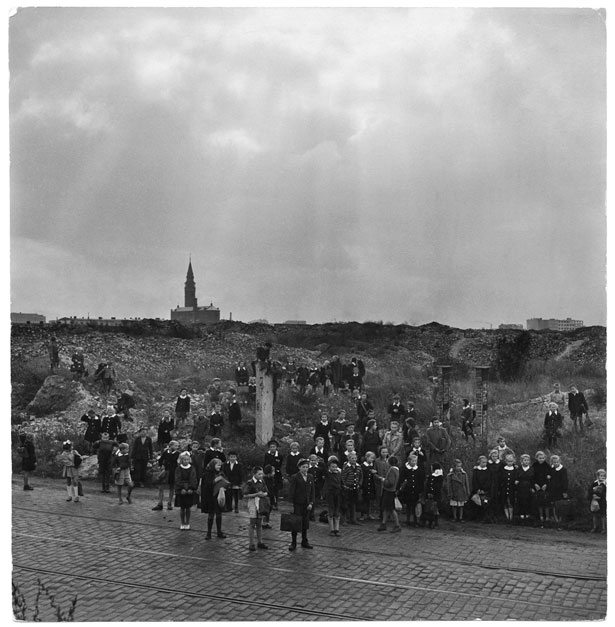
[Schoolchildren waiting for a bus in the ruins of the destroyed ghetto, Warsaw], 1948. © David Seymour/Magnum Photos
This was partly circumstance: the fight against fascism engendered a distinctly political form of solidarity. When the left’s failures in the coming decades—from Stalinist apologetics to parliamentary betrayal—led to disillusion throughout Europe and the United States, this solidarity was hard to capture again. Chim’s images don’t thrill in battle, nor do they mourn or dispassionately document suffering. To find something similar to the deep engagement of his photographs, look at the images taken during the past century’s other struggles of common purpose: Nicolas Tikhomiroff’s photographs of Algerian decolonization; Serge Hambourg’s from the streets of Paris in 1968; the work of the Afrapix collective through the end of apartheid in South Africa. Chim’s photographs find their natural home among the other documents of global anti-oppression movements that not only preserve histories, but also inspire both contemporaneous and future calls for justice without succumbing to an apolitical humanitarian sympathy.
Ours is an age of polarization and politicization, of shifting alliances and deepening inequalities. To a certain extent, the fruits of capitalism are now spread more evenly across the globe, but the power rests in the hands of a shrinking number of increasingly insulated brokers. The economic stratification occurring worldwide has made the tastes and lifestyles of the rich in Hanoi similar to those in New Delhi, Moscow or Mexico City, and has left those countries’ poor populations increasingly alike in the ways that they have been driven to the lowest reaches of the global economic hierarchy, or forced to subsist outside of it entirely. The image-makers of our own era could find worse models than Chim in their pursuit of making these similarities a source of solidarity rather than a study in comparative exploitation.
In April, Jana Prikryl surveyed the oeuvre of famed photographer Roman Vishniac.


